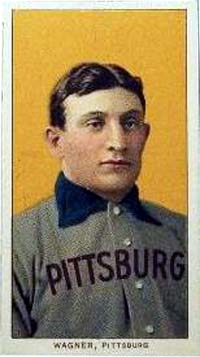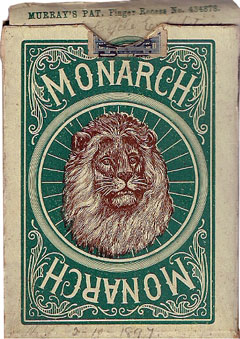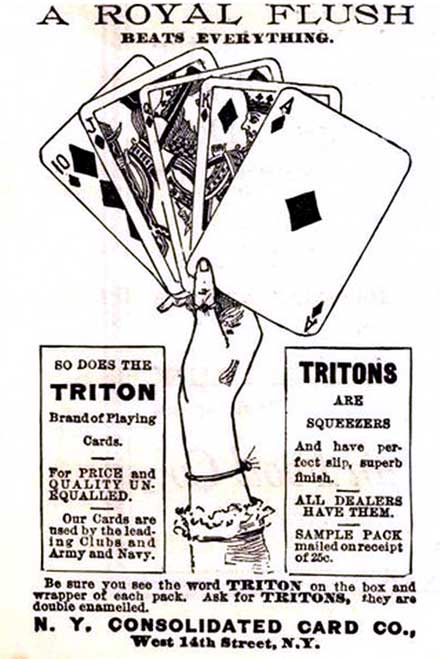Is Card Collecting an Investment?
“Is Card Collecting an Investment?” - an article by Rod Starling.
This article originally appeared in the December 2013 issue of ‘Clear the Decks’, the Newsletter for 52 Plus Joker, the American Playing Card Collector’s Club.
This is no doubt a sensitive question. Actually, I am of the opinion that most collectors hold on to their collections without any thought of selling them in which case the question may well be academic. Nevertheless, there are aspects to the question of value that I think merit discussion. The main factor that I consider when acquiring a deck of cards is the pleasure that I derive from it - I give no thought as to whether or not any given deck will appreciate in value and I am sure most collectors are probably of the same mind set. I must admit, however, that there is always the vague hope in the back of my mind that there will be a general appreciation in value over a period of time which should be a reasonable hope and again, one that we should all be entitled to believe in. Unfortunately, as I will explain below, appreciation in value is not always a reality but since the question may be academic, we should not allow the market place to detract from the pleasures that we derive from our hobby.
I will not attempt to define what makes a deck of cards valuable beyond stating the obvious, namely that rarity, condition and subject matter are essential elements. It is the latter element, the subject matter, which presents the greatest difficulty when attempting to establish or decide whether or not a given deck has the potential to be valuable. It is usually a matter of personal preference, or taste if you will, and since there is no accounting for taste, attempts to affix valuation on that basis will always be difficult. The field of Fine Arts provides many examples where personal preferences clash with otherwise standard “norms”. Works of “fine art” that almost hurt the eye can command prices in the millions of dollars. I happen to think that at least half of what passes as “fine art” is really just a fine mess. On May 3, 2013 Christie’s, Manhattan, auctioned a “drip and splatter” painting, which is to say a painting executed by the random dripping and splattering of various colored paints upon a canvas. It sold for $58.4 million dollars. That’s FIFTY-EIGHT MILLION, FOUR HUNDRED THOUSAND DOLLARS!! I am no art critic but I have seen examples of the “drip and splatter” so-called art and I’m sorry but that 58.4 million dollar sale at Christie’s has got to go down as the most colossal example of The Emperor’s New Clothes farce that has ever been recorded.*
Retuning now to our humble but real world of playing cards and laying aside all attempts to reconcile personal preferences, there remains one important issue that needs to be addressed, namely: Why is it that playing cards, as collectables, have never had the following or achieved even the status and respectability of other collectables such as coins, stamps, comic books and other items. Even sports cards have a greater following, with some single specimens achieving values in the hundreds and even thousands of dollars.

Above: Honus Wagner baseball card issued by the American Tobacco Company, 1909. 2½ x 1½ inches.
Almost certainly collectors value their collections largely on the basis of the particular personal appeal that the decks hold for them rather than on any considerations of possible appreciation in value. Nevertheless, I do not see why the field should be denied a legitimate standing in the market place or why, for that matter, the values of certain decks either fail to appreciate or, as I shall show below, actually depreciate in value. It is difficult, however, to establish any sort of a baseline with respect to the value of decks, even 19th century decks. Before the advent of eBay, at a time when the late Gene Hochman conducted his semi-monthly mail auctions and was “the only game in town”, collectors had a better idea of what the values were for certain decks even though Gene never published a “prices realized” list for any of his auctions, and they ran for ten years!
I think that it can be safely said that eBay has made a big difference with respect to the evaluating of decks but the difference is erratic and seemingly unreliable. Nevertheless, I have made an effort to make some sense of eBay’s auctions and I have come to the conclusion that there are very few serious card collectors in the entire world! By serious, I mean a collector who will pay serious money when a worthy deck is in the offing. Our club’s April, 2013 auction offered an example of what I mean. It included a Lawrence & Cohen Illuminated deck, c.1863, in near mint condition and featuring the liberal use of gold throughout the entire deck. There can be no question but that the deck is beautiful, very rare and presumably coveted by collectors. Yet there were only two bidders and the price realized was only $1,075.00. TWO BIDDERS? - and at that price? I know for a fact that on at least two occasions in the past, the deck has sold for over $2,000.00 and for as much as $2,500.00. It is true that the deck in the auction was a 32 card complete deck as compared to the full 52 card set but that cannot account for the great disparity in the price. Perhaps the fact that the auction offering mentioned that the deck was one of four such decks found in a Bezique set inadvertently gave the impression that it was not so rare. In fact, it is rare and the lucky winning bidder got a real bargain.
The club auction also supports my conclusion that there really are few card collectors in the world, serious or otherwise. Although the auction was a success in the sense that all but two lots received bids, one would think that a club, consisting of about 450 card collectors, would be able to muster more than 76 bidders on its auction. I have noticed the same paucity of bidders on eBay’s auctions which are viewed worldwide. It may very well be that if there are in fact so few collectors, it must eventually follow that supply will exceed demand and in that event, prices, unfortunately, may go down. Again, eBay may be the cause. It seems to me that it is only a matter of time before most sought after decks will appear on its auction lists and sometimes even appear often. As a result, the few serious collectors eventually acquire the decks that they want only to find that more copies of the decks surface later and fail to bring the higher prices previously realized. As I pointed out above, the auction of the Lawrence & Cohen deck would seem to be a good example.

Above: “Monarch Bicycle” playing cards, 1895.
Another case in point involves the rare and very interesting 1895 Monarch Bicycle deck, (Hoch A12). It is a magnificent early advertising deck with special court cards that appear to be the proto type of those used in the Stage No.65 deck issued a year later. On March 1, 2012 a copy of the deck having 52 cards plus the Joker, plus a special extra card, in excellent condition and in the original box that appeared to be a grade of an 8 on a scale of 1 to 10, sold on eBay for $887. There were only six bidders! A year later, on March 14, 2013 a copy of the deck in the same condition, complete in all respects and in the original box, sold on eBay for $355 and there were just 8 bidders. The same bidder won both decks! The Monarch Bicycle deck is about as serious a collectable deck as you could ask for and yet look what happened. Just a very few bidders from a world-wide pool of bidders and the best that the deck could realize on its last offering was a mere $355, a drop of $532 from its previous price! That does not bode well from an investment standpoint.
Our esteemed editor, Judy Dawson, once wrote, that with me, all roads lead to the Norwood 85 deck, so here I go again. Gene Hochman valued the Norwood 85 deck at $5,000.00 and that was over 25 years ago. On October 31, 2005, the deck appeared in an auction held by Skinner’s of Boston. It had 52 cards plus Joker and the back design of The Storm and was in mint condition and in the original box with a 1919 tax stamp. It even included the original cellophane inner wrapper. There are fewer than a dozen copies of the deck known to exist and three are in museums. Nevertheless, it sold for only $2,600.00 and by today’s standards most collectors would probably consider that the price was too high. I don’t get it - $2,600.00 for deck of which there are fewer than 12 copies in existence and 2.8 million dollars for a single baseball card of which there are at least 60 known specimens, not to mention, heaven only knows, how many fakes. So why is that? When I compare such facts, I feel as if I just fell down Alice’s rabbit hole. Things “get curiouser and curiouser”

Above: French Costume playing cards published by O. Gibert, Paris, c.1850
Mentioning Judy reminds me that she did an article for the December, 2006 edition of this newsletter in which she exhibited four French Costume cards that date from around the middle of the 19th century. As Judy pointed out, these finely engraved and delicately hand-colored cards are little works of art. In my opinion, they could be museum pieces. I too exhibited a deck from the French Costume series in an article that I did for the June, 2008 edition of this newsletter. If you are able, you should look up the two articles on the club website where the cards can be seen in full color. Given their beauty, art, age and relative rareness, I believe that they should command high prices consistent with their intrinsic value and museum like status. However, from what I have been able to observe, the decks have only realized prices between $500.00 and $800.00. To me, that is incomprehensible.
By the most conservative evaluation, those decks should be recognized for the attributes they possess at several levels. First, there is the fine engraving. Some early engravings, like those of Albrecht Durer and Martin Schongauer, command very high prices. Many of Albrecht Durer’s works, like his Saint Paul; Knight, Death and the Devil, are in the Metropolitan Museum of Art in New York City. A great deal of homage has rightly been paid to the work of early master engravers and even to engravers whose identities are unknown and yet, it seems that higher criticism, positive or negative, is not to be found with respect to the French engraved Costume Cards. Secondly is the hand-coloring which is delicate and exquisite. And last, these wonderful decks provide a window through which we may see dress styles, both contemporary and historical, and with some historical characters even named and represented as the court cards. Accordingly, the cards have historical and cultural value but apparently they cannot compare to the single, 2.8 million dollar baseball card. How absurd.
While today, the French Costume cards do not enjoy the recognition they deserve, it seems to me that they were fully appreciated by those who obtained them when they were first produced. I say that because it has been my experience that when these decks surface for sale, they are invariably found to have been kept in excellent to mint condition indicating that their value was fully appreciated. One has only to glance at the cards to realize that they are hand-engraved, hand-colored, made in a very limited quantity and therefore rare.
In the final analysis, I think that the public’s general state of ignorance of and its indifference to playing cards, coupled with the long standing prejudicial, negative association with gambling and other vices, accounts for its near total disconnect with the field. Witness the comparatively small number of collectors of cards as compared to the collectors of stamps, coins, comic books, sports cards and even post cards. It was an awareness of that disconnect that inspired me to write the book The Art and Pleasures of Playing Cards. Unfortunately, being a “print on demand” publication, the cost of each book was prohibitive thereby making sales near impossible.
Nevertheless, in a further effort to introduce the general public to the pleasures of our hobby, I have partnered with this website where many significant decks from my collection are now on display along with informative notes provided by the webmaster, Simon Wintle and myself. The website is in the United Kingdom and Simon tells me that it is getting many hits and that my decks in particular have drawn favorable comments. Will all the pros and cons finally weigh in favor of regarding card collecting as an investment? Of course, I don’t know but I am not overly concerned about the actual “cash value” of cards. I am much more interested in having their historical and cultural values recognized. For me, those values are reward enough.

I would be remiss if I did not record at least one positive eBay experience with respect to one particular deck namely, New York Consolidated Card Company’s Triton No.42. (NY50a)►
The deck, while perhaps not particularly rare, does feature a very nice Ace of Spades and Joker. It has recently enjoyed an energetic market on eBay but I will begin with the auction of June 10, 2002, when the deck in an OB9 with 52 cards, plus Joker, in mint condition and with gold edges, sold for $75. There were four bidders. On November 15, 2007, the deck in the same condition but in an OB 6-, sold for the same $75 and there were nine bidders. On April 28, 2009, the deck in the same condition but without gold edges and in an OB 6 sold for $128 and there were two bidders. Finally, on June 12, 2013, the deck with 52 cards, plus Joker in near mint condition and in an OB 8, sold for $230. It included the sorters notice and an extra misprinted Ace of Spades. It also had very nice back design featuring a Victorian child and a dog, all very attractively colored. So it would appear that appreciation in value is possible but if eBay is to be the gauge, too many factors make any predictions difficult and risky. SO let’s just enjoy our decks.
* Note: *The Emperor’s New Clothes by Hans Christian Andersen, pub.1837 tells the tale of a vain Emperor, concerned only with his appearance, was swindled by two tailors into believing that they would make him an outfit of the finest fabric that would be invisible to anyone who was unfit for his position or hopelessly stupid. Everyone, not wanting to be found unfit and stupid, including the emperor, went along with the farce but when the Emperor appeared in a procession, a child in the crowd blurted out that the Emperor was not wearing clothes. Although fearing that the child was correct, the Emperor continued on with procession. This was Andersen’s little jibe at hypocrisy and snobbery. There should be such a child in every art salon.
Editor’s Note: one thing for sure - the costume decks which are so finely engraved and truly lovely, both in colorings and design, are far more attractive and fun to look at than the glum and rather dull picture of Honus Wagner! However I guess those factors are not the criteria for the buyers of baseball cards. Like Rod, I can only marvel at the absurdity of spending so much money on something which could easily go up in flames but of course this card must be tucked away in a safe somewhere, never to see the light of day, unlike our playing cards which we can enjoy whenever we want to!
There is no doubt in any collector or dealer’s mind that wonderful vintage and antique items have suffered considerably with the advent of eBay. There are a number of reasons for the declining prices in every field but let’s just discuss playing cards and related items. Here are my thoughts.
I have done eBay pretty much ever since its inception, both as a buyer and even more as a seller. It was very exciting in the early years when prices realised were often more than you could ever have dreamed of. When we were first collecting there were a number of elusive but known decks actively sought after by collectors. The one deck that took us a number of years to acquire was my favorite, the Murphy Varnish advertising and transformation deck with its fabulous and clever court cards. While it is still difficult to find, especially in mint condition, it would now be possible to find one in much less time if you really wanted it.
EBay has created this difference. There are a number of decks once deemed rare which have surfaced a number of times on eBay, therefore decreasing their value. On the other hand, some of the decks which did not seem hard to find in the past have become very elusive. Among these are any of the five “Mystic” Series #888 decks put out by USPC in 1898 (Hochman US22). In earlier days of our collecting we never dreamt that these beautiful decks with their brightly colored backs and great jokers would be difficult for us to add or upgrade to ur USPC collection but we were wrong. With careful searching, we do own all five BUT our “Elks” has no Joker or box and is not mint Our “Goat” box is only OB2- and missing the top flap. We have never had a chance to better them in many years, even on eBay. (Our other three are great!)
Another factor for declining prices is the lack of young collectors. This is true in all antique fields. Computers have captured their interest and with the world opening up its doors, antique collecting is slowly declining. However, like anything, collecting things from our past will come round again and the scarcity and beauty of old playing cards will once again become desirable and thus valuable.
Ebay has made playing cards very available but I rarely search it any more as our category has grown so large that it takes me much too long to find anything unusual; thus my interest in looking there has waned. I prefer to buy, sell and trade with club members and to use our club auctions where, even after years of collecting, we generally find something special to add to our collection! - Judy Dawson.

By Rod Starling (1936-2023)
Member since January 09, 2013
Rod Starling was one of the founding members of the 52 Plus Joker card collectors club. He authored many articles for the club's quarterly newsletter, Clear the Decks. His collection encompasses both foreign and American decks. Rod also authored a book titled The Art and Pleasures of Playing Cards.
Related Articles

Rap Rummy
Rap Rummy made by Parker Brothers in 1926, only 4 years after the discovery of King Tutankhamen’s to...

German Travel Cards
A travel-themed educational deck helping American tourists visiting Germany.

Can You Believe Your Eyes?
“Can You Believe Your Eyes?” playing cards featuring visual illusions & other oddities.

Get Decked
Black and white cartoons devised by Sam Wagner with help from artist Lindsay Bevington.

Beowulf
Jackson Robinson's Beowulf playing card deck inspired by the Old English pagan poem.

Keith Haring playing cards
Energetic graffiti images by the American artist Keith Haring.

The Tarot of Meditation – Yeager Tarot
Marty Yeager’s original Tarot of Meditation from 1975, republished later by U.S. Games Systems, Inc....

Adobe Deck
The first digitally-produced deck of cards.

Seminole Wars deck
Seminole Wars deck by J. Y. Humphreys, Philadelphia, c.1819.

The UCR Deck
Giant-size cards designed by Thomas Sanders to advertise courses and facilities at UCR.

Fredericks & Mae playing cards
A rainbow pack from the design team of Fredericks & Mae and Benjamin English.

Red Hat Society playing cards
Society that encourages women in their quest to get the most out of life.

Mountain Dream Tarot
Groundbreaking Tarot created by Bea Nettles, using photographs and photo montage.

Junior Playing Cards
Child-friendly versions of standard English pattern cards designed by Louie Mantia, Jr.

Last Call Cats playing cards
Bar-crawling cats, designed by artists Arna Miller and Ravi Zupa.

Covered bridges playing cards
Historical covered bridges with photography by Bill Miller, 2006.
Most Popular
Our top articles from the past 28 days

